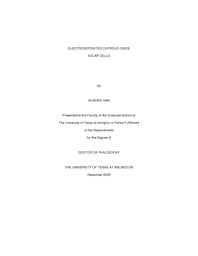
ATTENTION: The works hosted here are being migrated to a new repository that will consolidate resources, improve discoverability, and better show UTA's research impact on the global community. We will update authors as the migration progresses. Please see MavMatrix for more information.
Show simple item record
| dc.contributor.author | Han, Kunhee | en_US |
| dc.date.accessioned | 2010-03-03T23:30:45Z | |
| dc.date.available | 2010-03-03T23:30:45Z | |
| dc.date.issued | 2010-03-03T23:30:45Z | |
| dc.date.submitted | January 2009 | en_US |
| dc.identifier.other | DISS-10521 | en_US |
| dc.identifier.uri | http://hdl.handle.net/10106/2078 | |
| dc.description.abstract | The electrochemically deposited cuprous oxide (Cu₂O) as a photovoltaic absorber material is introduced in this work. The electrical, structural, and optical characteristics of electrodeposited Cu₂O are well investigated. The pH of the deposition solution controls the flat band voltage of Cu₂O. The variation of the flat band voltage by solution pH is related to oxygen incorporation in the film, which is controlled by the amount of oxygen precursor, OH-, in the solution. Hence, the high pH in the solution is preferable for producing a p-type Cu₂O with copper vacancy, while the low pH in the solution is preferable for producing an n-type Cu₂O with oxygen vacancy or copper interstitial. The resistivity of Cu₂O is controlled by the deposition solution pH. As the pH of a solution increases, the resistivity of Cu₂O decreases. The crystal orientation and the grain size have significant roles in controlling the resistivity of p-type Cu₂O. Cu₂O with a crystal orientation of (111) shows lower resistivity than Cu₂O with a crystal orientation of (100). A possible reason for this is that Cu₂O with (111) orientation grows in the solution of high pH, and it leads to a more intrinsic point defect, i.e, Cu vacancies that determine the carrier concentration in the film. Electrodeposited Cu₂O shows a direct band gap of ~2.06 eV, which is independent of the deposition condition. Cu₂O p-n homojunction solar cells with two different structures are successfully fabricated by a two-step electrodeposition method. The highest efficiency of 0.15% is achieved in an electrodeposited Cu₂O substrate solar cell. The solution bath pH of n-Cu₂O controls the open circuit voltage of the device. Several pin holes which were observed in the device contribute to the formation of shunt paths and cause the degradation of solar cell performance in the large superstrate solar cells. The thermal reliability test indicates that the device performance of the Cu₂O solar cell is not stable above the temperature of 150 degree C. The Cu₂O superstrate solar cell exhibits better device performance than the Cu₂O substrate cell. The thickness of the p-Cu₂O layer influences the open circuit voltage of superstrate cells. Low efficiency of Cu₂O solar cells is mainly influenced by the high resistivity of both the p and the n-Cu₂O. In order to control the electrical properties of Cu₂O, two different n-type doping techniques, thermal diffusion doping and electro doping, are introduced. The resistivity of Cu₂O is successfully controlled by Cu thermal diffusion. Also, the Fermi energy of Cu₂O is shifted and the n type property of Cu₂O is enhanced by Cu diffusion. This confirms that the intrinsic point defects in Cu₂O, such as copper vacancy and oxygen vacancy, are controlled by external copper diffusion. It is speculated that Cu diffusion in Cu₂O takes place mainly along grain boundaries (100) at the beginning of the annealing process, and then lattice diffusion follows along the (111) planes, due to its lower lattice distortion. N type electrodoping in Cu₂O is successfully achieved with Br ion. Br concentration plays a significant role in the crystal growth. The formation of a dendritic crystal of Cu₂O is caused by Br in the solution. It is believed that the mechanism of electrodoping is the co-deposition of the n-type dopant with Cu₂O. | en_US |
| dc.description.sponsorship | Tao, Meng | en_US |
| dc.language.iso | EN | en_US |
| dc.publisher | Electrical Engineering | en_US |
| dc.title | Electrodeposited Cuprous Oxide Solar Cells | en_US |
| dc.type | Ph.D. | en_US |
| dc.contributor.committeeChair | Tao, Meng | en_US |
| dc.degree.department | Electrical Engineering | en_US |
| dc.degree.discipline | Electrical Engineering | en_US |
| dc.degree.grantor | University of Texas at Arlington | en_US |
| dc.degree.level | doctoral | en_US |
| dc.degree.name | Ph.D. | en_US |
| dc.identifier.externalLink | https://www.uta.edu/ra/real/editprofile.php?onlyview=1&pid=291 | |
| dc.identifier.externalLinkDescription | Link to Research Profiles | |
Files in this item
- Name:
- Han_uta_2502D_10521.pdf
- Size:
- 11.05Mb
- Format:
- PDF
This item appears in the following Collection(s)
Show simple item record


